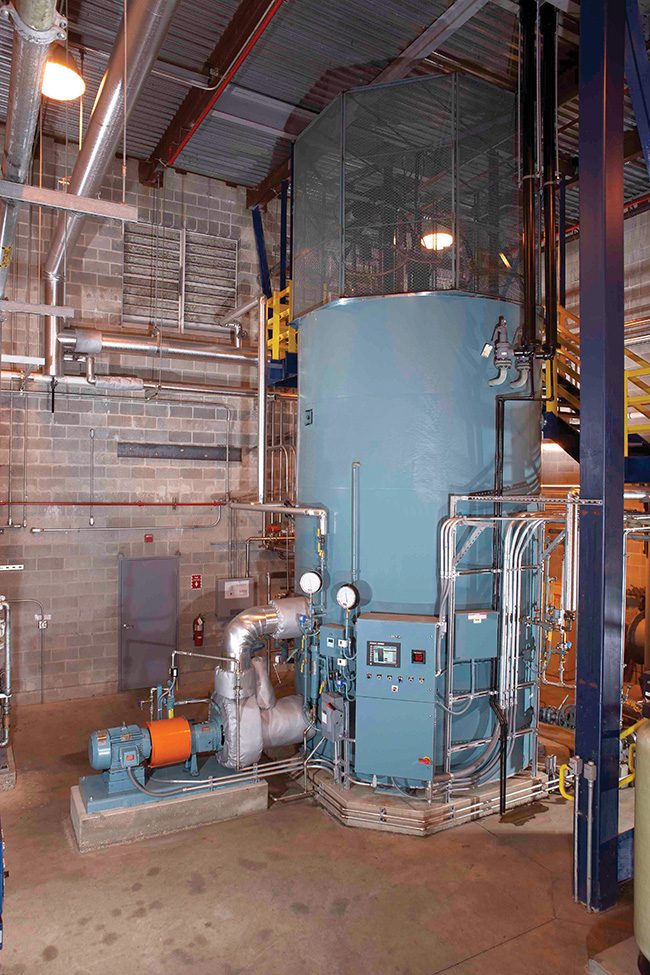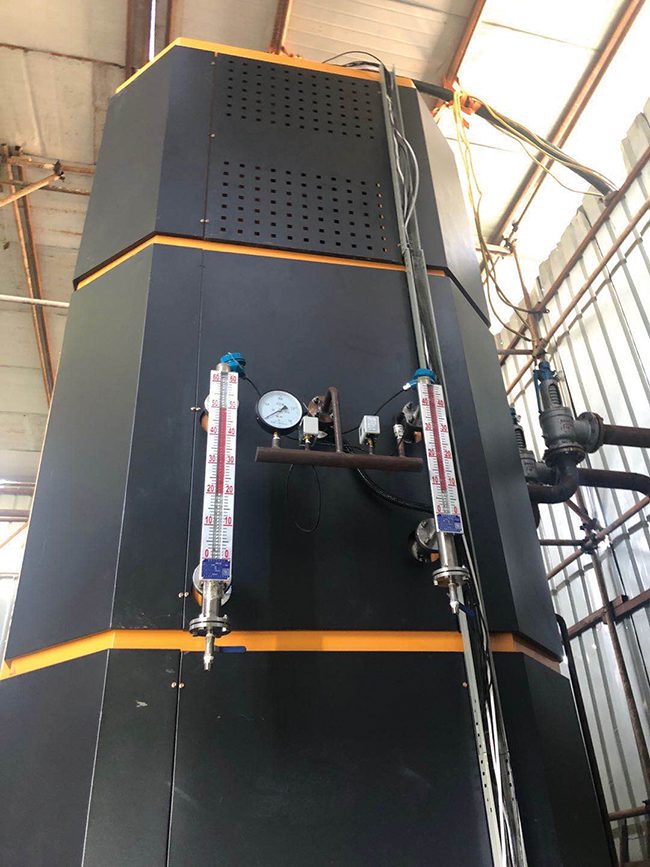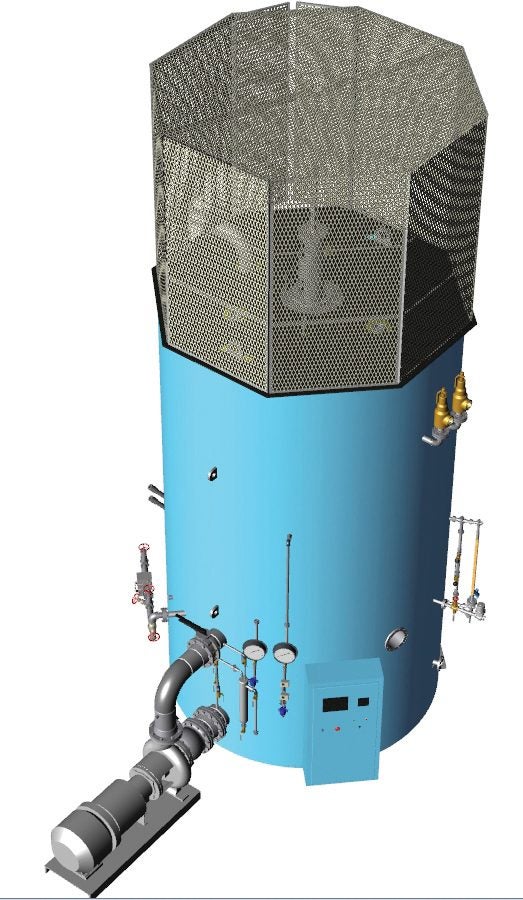Auxiliary Boilers Can Reduce Cold-Start Times for CCGTs
Combined cycle gas turbines (CCGTs) play a critical role in providing power grids with additional electricity, supporting reliability and resilience during periods of high demand. Combined cycle power plants that harness energy from both combustion and steam turbines use less fuel overall, and can produce longer run times than traditional peaker plants that have long been used to produce electricity on demand.
Depending on the condition of a region’s electrical grid, CCGT plants may need to be operated for several hours each day, or just occasionally during a week, or perhaps even only a few times each year. However, regardless of their cycle frequency, these peaker plants must be able to quickly ramp up as they transition from “off” to “on” status.
One of the challenges for CCGT plants in that regard comes with starting steam turbines quickly after being offline. In a combined cycle power plant, a gas turbine initially generates electricity. The waste heat from the gas turbine is then captured via a heat recovery steam generator (HRSG), which produces pressurized steam that goes to the steam turbine, enabling the power plant to generate additional electric power.
 |
|
1. To be ready to provide energy as quickly as possible, combined cycle gas turbine (CCGT) plants can use auxiliary boilers to reduce the cold startup time of their steam turbines. Courtesy: Acme Engineering |
In order to be ready to provide energy as quickly as possible, CCGT plants use auxiliary boilers (Figure 1) to reduce the cold startup time of their steam turbines, a process that can save as much as 30 minutes per cycle. These boilers also play a critical role in maintaining the readiness of condensers, equipment whose function is to turn the steam recovered from the turbines back into water.
“You have to generate the steam to start the turbine turning and that is one of the major uses of auxiliary boilers,” said Robert Presser, vice president of Acme Engineering, a manufacturer of industrial and commercial boilers with operations in the U.S., Canada, and Europe. “When you need an auxiliary boiler to start the turbine, you need a lot of power and you need it fast.”
Managing an ‘On Again, Off Again’ Relationship
Acme Engineering was asked to provide a 3-MW conventional electric boiler system for Goreway Power Station in Brampton, Ontario. The 875-MW natural gas-fueled combined cycle plant, which came online in 2009 and is today owned by Capital Power, is available to provide the Ontario Independent Electricity System Operator with power on a continuous basis, though it primarily operates as a peaker plant during intermediate and peak demand periods.
Unlike traditional peaker plants that may be tasked with supplying energy periodically, often with long and predictable periods offline, the Goreway station must manage a daily online/offline rhythm. “We typically cycle on and off multiple times a day,” said Chad Donnelly, shift engineer at Goreway. “We need to support morning peak, then we’ll shut down through the mid-day peak before restarting for the evening peak and then typically shut down for overnight.”
When the main HRSG boiler is offline, superheated steam and pressure is lost, and Goreway uses an auxiliary boiler to supply steam to maintain the condenser vacuum. This required the plant’s engineering team to develop an operating cadence to maximize the plant’s readiness to provide energy efficiently.
“We use an auxiliary boiler to ramp up an hour before shutdown and supply the shaft seal with steam while the units are down so the plant is ready for a quick start in the morning,” said Donnelly. “Using an auxiliary boiler increases the flexibility of the facility because we only have to run this small auxiliary boiler to maintain a vacuum in the condenser.”
Going Electric
The Goreway engineering team, after considering options, selected a 3-MW electrode-based electrical boiler from Acme Engineering as their auxiliary boiler. In addition, Acme Engineering integrated the feedwater pumps that go to the boiler, a steam separator, and an electric steam superheater, and delivered the equipment on a skid as a complete system.
 |
|
2. Electric boiler systems offer CCGT plants a highly configurable solution for the operational readiness of their steam turbines. Courtesy: Acme Engineering |
The flexibility, precision, and responsiveness of modern electrode boilers (Figure 2) allows cost-effective “on-demand” superheated steam almost immediately. Presser noted, “A gas-fired boiler cannot go from zero to 100% capacity in less than two minutes—but an electrode boiler can.” He pointed out that modern electrode boilers are designed so temperature, pressure, and output can quickly rise or fall as needed with no “flywheel effect.”
Electrode boilers have existed in various forms for decades, but recent design improvements have closed the output gap, while surpassing conventional units not only in terms of efficiency and simplicity but also responsiveness and safety.
Modern electrode boilers utilize the conductive and resistive properties of water to carry electric current and generate steam. In a jet boiler, water jets flow from a central column to electrodes of each phase, using chemicals in the water to create resistance, and generate heat and steam as the water passes from ground to phase. More steam is produced as the water flows from the electrode to the counter electrode placed below the electrode box, before the water returns to the reservoir at the bottom of the vessel.
“The more current [amps] that flows, the more heat [Btus, or British Thermal Units] is generated and the more steam produced. Nearly 100% of the electrical energy is converted into heat with no exhaust stack or heat transfer losses,” said Presser.
 |
|
3. Advantages of electric boilers include a fast start-shutdown cycle speed, convenient, operation and maintenance, and energy efficiency. Courtesy: Acme Engineering |
Other advantages of electric boilers (Figure 3) include a fast start-shutdown cycle speed, a high degree of control and accuracy in temperature, energy efficiency, convenient operation and maintenance, and low carbon emissions.
“It’s an environmental win because instead of burning more fossil fuel, Goreway is running on off-peak electricity to supply our auxiliary boiler,” said Donnelly. “Off-peak electricity is generally pretty green, too, as it is provided by the nuclear stack or excess wind generation when we are offline.”
Goreway runs its auxiliary boiler in a warm standby mode, maintaining a slight 200 kPa pressure inside the drum for even quicker startup and chemistry stability.
“An hour before shutdown, we essentially just hit ‘boiler start’ and it changes the setpoint to 700 [kPa] and it comes online,” said Donnelly. “Once the steam flow is established, the superheater comes online to dry the saturated steam, increase its thermal energy, and reduce the risk of condensation as compared to unheated saturated steam.”
Donnelly acknowledged that on a large-scale, sustained basis, it may be less expensive to operate a gas-powered auxiliary boiler system. However, he noted that a power plant needs to already have a gas supply, gas contracts, environmental contracts, and operators that are experienced in using natural gas.
In Goreway’s situation, since the plant was already under construction when they were selecting an auxiliary boiler system, they did not want to delay construction or incur the added costs by bringing in natural gas lines for an auxiliary boiler and new environmental permit, so the plant’s operators chose an electric solution.
Maximizing Efficiencies Through Co-Location
One of the benefits of using an electric auxiliary boiler is the versatility about where to locate equipment. Since operationalizing their electrode system, Donnelly said he has new insight on what would make an ideal configuration. He recommended locating a separately fired electric superheater close to where the steam is needed to minimize temperature loss.
“With a conventional boiler, you just can’t do that because it’s kind of an all-in-one package,” he said. In Goreway’s case, Donnelly judged the ideal location as the sealed-steam skid, because the saturated steam can go from the HRSGs to the electric superheater until the pressure decays, then the electric boiler can supply steam until the next startup.
Electric boiler systems offer CCGT plants a highly configurable solution for the operational readiness of their steam turbines. From accelerated starts to robust support for maintaining condenser vacuum, they are a targeted “clean and green” component that can be easily configured to each plant’s unique needs.
—This article was contributed by Acme Engineering. Inquiries should be sent to Robert Presser ([email protected]), or visit acmeprod.com/jet-type-steam-boiler to learn more.